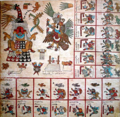
Codex Borbonicus
Encyclopedia

Aztec codices
Aztec codices are books written by pre-Columbian and colonial-era Aztecs. These codices provide some of the best primary sources for Aztec culture....
written by Aztec priests shortly before or after the Spanish conquest of Mexico
Spanish conquest of Mexico
The Spanish conquest of the Aztec Empire was one of the most important campaigns in the Spanish colonization of the Americas. The invasion began in February 1519 and was acclaimed victorious on August 13, 1521, by a coalition army of Spanish conquistadors and Tlaxcalan warriors led by Hernán Cortés...
. The codex is named after the Palais Bourbon
Palais Bourbon
The Palais Bourbon, , a palace located on the left bank of the Seine, across from the Place de la Concorde, Paris , is the seat of the French National Assembly, the lower legislative chamber of the French government.-History:...
in France
France
The French Republic , The French Republic , The French Republic , (commonly known as France , is a unitary semi-presidential republic in Western Europe with several overseas territories and islands located on other continents and in the Indian, Pacific, and Atlantic oceans. Metropolitan France...
. It is held at the Bibliothèque de l'Assemblée Nationale in Paris. In 2004 Maarten Jansen and Gabina Aurora Pérez Jiménez proposed that it be given the indigenous name Codex Cihuacoatl, after the goddess Cihuacoatl
Cihuacoatl
In Aztec mythology, Cihuacoatl was one of a number of motherhood and fertility goddesses....
.
The Codex Borbonicus is a single 46.5 feet (14.2 m) long sheet of amatl
Amatl
Amate is a form of paper that has been manufactured in Mexico since the pre Hispanic times. Amate paper was extensively produced and used for both communication, records and ritual during the Aztec Empire; however, after the Spanish conquest, its production was mostly banned and replaced by...
"paper". Although there were originally 40 accordion-folded pages, the first two and the last two pages are missing. Like all pre-Columbian codices, it was originally entirely pictorial in nature, although some Spanish descriptions were later added. There is dispute as to whether the Codex Borbonicus is pre-Columbian, as the calendar pictures all contain room above them for Spanish descriptions.
Codex Borbonicus can be divided into three sections:
The first section is one of the most intricate surviving divinatory calendars (or tonalamatl
Tonalamatl
The tonalamatl is a divinatory almanac used in central Mexico in the decades, and perhaps centuries, leading up to the Spanish conquest. The word itself is Nahuatl in origin, meaning "pages of days"....
). Each page represents one of the 20 trecena
Trecena
A trecena is a 13-day period used in pre-Columbian Mesoamerican calendars. The 260-day calendar was divided into 20 trecenas. Trecena is derived from the Spanish chroniclers and translates to 'a group of thirteen' in the same way that a dozen relates to the number twelve...
(or 13-day periods), in the tonalpohualli
Tonalpohualli
The tonalpohualli, a Nahuatl word meaning "count of days", is a 260-day sacred period in use in pre-Columbian Mesoamerica, especially among the Aztecs. This calendrical period is neither solar nor lunar, but rather consists of 20 trecena, or 13-day periods...
(or 260-day year). Most of the page is taken up with a painting of the ruling deity or deities, with the remainder taken up with the 13 day-signs of the trecena and 13 other glyphs and deities.
With these 26 symbols, the priests were able to create horoscopes and divine the future. The first 18 pages of the codex (all that remain of the original 20) show considerably more wear than the last sections, very likely indicating that these pages were consulted more often.
The second section of the codex documents the Mesoamerican 52 year cycle, showing in order the dates of the first days of each of these 52 solar years. These days are correlated with the nine Lords of the Night.
The third section is focused on rituals and ceremonies, particularly those that end the 52-year cycle, when the "new fire
New Fire ceremony
The New Fire ceremony was an Aztec ceremony performed once every 52 years — a full cycle of the Aztec calendar— in order to stave off the end of the world....
" must be lit. This section is unfinished.

